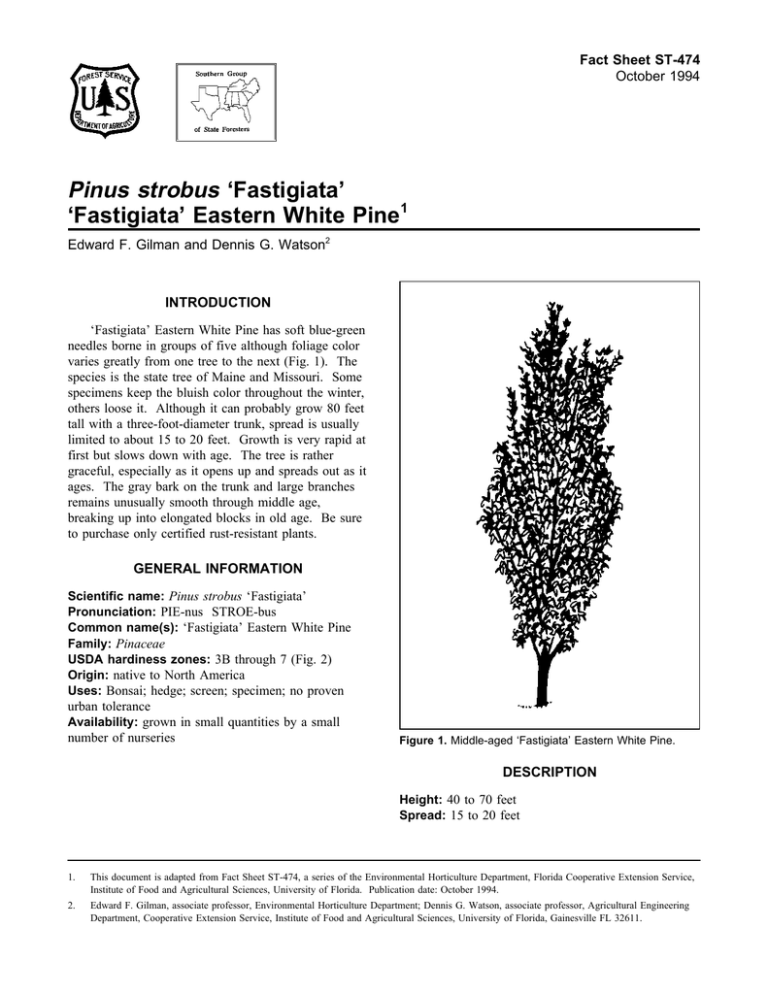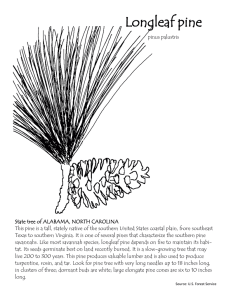Pinus strobus ‘Fastigiata’ ‘Fastigiata’ Eastern White Pine Fact Sheet ST-474 1
advertisement

Fact Sheet ST-474 October 1994 Pinus strobus ‘Fastigiata’ ‘Fastigiata’ Eastern White Pine1 Edward F. Gilman and Dennis G. Watson2 INTRODUCTION ‘Fastigiata’ Eastern White Pine has soft blue-green needles borne in groups of five although foliage color varies greatly from one tree to the next (Fig. 1). The species is the state tree of Maine and Missouri. Some specimens keep the bluish color throughout the winter, others loose it. Although it can probably grow 80 feet tall with a three-foot-diameter trunk, spread is usually limited to about 15 to 20 feet. Growth is very rapid at first but slows down with age. The tree is rather graceful, especially as it opens up and spreads out as it ages. The gray bark on the trunk and large branches remains unusually smooth through middle age, breaking up into elongated blocks in old age. Be sure to purchase only certified rust-resistant plants. GENERAL INFORMATION Scientific name: Pinus strobus ‘Fastigiata’ Pronunciation: PIE-nus STROE-bus Common name(s): ‘Fastigiata’ Eastern White Pine Family: Pinaceae USDA hardiness zones: 3B through 7 (Fig. 2) Origin: native to North America Uses: Bonsai; hedge; screen; specimen; no proven urban tolerance Availability: grown in small quantities by a small number of nurseries Figure 1. Middle-aged ‘Fastigiata’ Eastern White Pine. DESCRIPTION Height: 40 to 70 feet Spread: 15 to 20 feet 1. This document is adapted from Fact Sheet ST-474, a series of the Environmental Horticulture Department, Florida Cooperative Extension Service, Institute of Food and Agricultural Sciences, University of Florida. Publication date: October 1994. 2. Edward F. Gilman, associate professor, Environmental Horticulture Department; Dennis G. Watson, associate professor, Agricultural Engineering Department, Cooperative Extension Service, Institute of Food and Agricultural Sciences, University of Florida, Gainesville FL 32611. Pinus strobus ‘Fastigiata’ -- ‘Fastigiata’ Eastern White Pine Page 2 Figure 2. Shaded area represents potential planting range. Crown uniformity: symmetrical canopy with a regular (or smooth) outline, and individuals have more or less identical crown forms Crown shape: columnar Crown density: moderate Growth rate: medium Texture: fine Foliage Leaf Leaf Leaf Leaf Leaf Leaf arrangement: alternate; spiral (Fig. 3) type: simple margin: entire shape: needle-like (filiform) venation: parallel type and persistence: evergreen; fragrant; needle leaf evergreen Leaf blade length: 2 to 4 inches Leaf color: blue or blue-green; green Fall color: no fall color change Fall characteristic: not showy Flower Flower color: pink; yellow Flower characteristics: inconspicuous and not showy; spring flowering Fruit Fruit Fruit Fruit Fruit Fruit shape: elongated length: 6 to 12 inches covering: dry or hard color: brown characteristics: does not attract wildlife; fruit, twigs, or foliage cause significant litter; persistent on the tree; showy Trunk and Branches Trunk/bark/branches: bark is thin and easily damaged from mechanical impact; grow mostly upright and will not droop; showy trunk; should be grown with a single leader; no thorns Pruning requirement: needs little pruning to develop a strong structure Breakage: susceptible to breakage either at the crotch due to poor collar formation, or the wood itself is Pinus strobus ‘Fastigiata’ -- ‘Fastigiata’ Eastern White Pine Page 3 Root systems are usually shallow and highly branched with many fine roots close to the surface of the soil. Trees transplant well balled and burlapped or from containers. The wood of the species is soft and is popular as a lumber tree in the northern part of the country. Young White Pines are quite tolerant of half-day shade while mature White Pines prefer a sunny location and tolerate loamy, moist, well-drained soils. They do not grow well and often die on clay or on soil with a pH above 7. Trees appear to have little tolerance for drought, soil compaction and heat and should be used only in the cooler climates. Eastern White Pine is susceptible to salt injury from roads or drain fields and is sensitive to air pollution (particularly ozone and sulfur dioxide). Figure 3. Foliage of ‘Fastigiata’ Eastern White Pine. weak and tends to break Current year twig color: brown; green Current year twig thickness: thin Wood specific gravity: 0.35 Culture Light requirement: tree grows in part shade/part sun; tree grows in full sun Soil tolerances: loam; sand; acidic; well-drained Drought tolerance: moderate Aerosol salt tolerance: none Other Roots: surface roots are usually not a problem Winter interest: no special winter interest Outstanding tree: tree has outstanding ornamental features and could be planted more Invasive potential: little, if any, potential at this time Verticillium wilt susceptibility: not known to be susceptible Pest resistance: very sensitive to one or more pests or diseases which can affect tree health or aesthetics USE AND MANAGEMENT The lower branches are retained making White Pine an excellent candidate for specimen use, although group plantings with trees spaced 15 to 25 feet apart add a soft accent to any landscape. Planted 8 to 15 feet apart they are one of only a few Pines which makes a nice hedge or screen of soft foliage. There are a few other cultivars: ‘Glauca’ - foliage bluish; ‘Nana’ - a dwarf, compact with short needles; ‘Pendula’ - weeping; ‘Prostrata’ - absolutely prostrate. Pests White Pine weevil is probably the biggest problem. The larvae of White Pine weevils feed on the sapwood of the leaders and this is devastating to the tree. The leader is killed and the many shoots replacing it form a bushy head. First symptoms are pearl white drops of resin on the leaders. The leaders die when the shoot is girdled as adults emerge in summer. Some adelgids will appear as white cottony growths on the bark. All types produce honeydew which may support sooty mold. European Pine shoot moth causes young shoots to fall over. The insects can be found in the shoots during spring. Infested shoots may exude resin. Bark beetles bore into trunks making small holes scattered up and down the trunk. Stressed trees are more susceptible to attack. The holes look like shotholes. Keep trees healthy to help prevent borers. Sawfly larvae caterpillars are variously colored but generally feed in groups on the needles. Some sawfly larvae will flex or rear back in unison when disturbed. Sawflies can cause rapid defoliation of branches if left unchecked. Pine needle miner larvae feed inside needles causing them to turn yellow and dry up. Pinus strobus ‘Fastigiata’ -- ‘Fastigiata’ Eastern White Pine Pine needle scale is a white, elongated scale found on the needles. Pine tortoise scale is brown and found on twigs. Depending on the scale, horticultural oil may control overwintering stages. Pine spittle bug lives and hides in a foamy mass. Spruce mites cause damage to older needles, and are usually active in the spring and fall. Mites cause older needles to become yellowed or stippled. Zimmerman Pine moth larvae bore into the trunk. The only outward symptoms may be death of parts of the tree or masses of hardened pitch on the branches. Diseases Procerva root rot kills most White Pines planted off site. Avoid planting in dry sites and never plant in clay or alkaline soil. White Pine blister rust attacks White Pine and uses currant as an alternate host. European Black Currant, the favored alternate host, may be banned from planting in certain areas. Other currants, particularly Red Currant should not be grown within 300 feet of Pines. Infected branches may be pruned off. Be sure to select White Pine trees certified to be rust-resistant. Canker diseases may rarely cause dieback of landscape Pines. Keep trees healthy and prune out the infected branches. Needle cast is common on small trees and plantation or forest trees. Infected needles yellow and fall off. White Pine decline is used to describe the slow decline of trees planted in dry, clay soils low in organic matter. Plants with this disorder have only a small cluster of needles at the ends of the branches. Page 4




